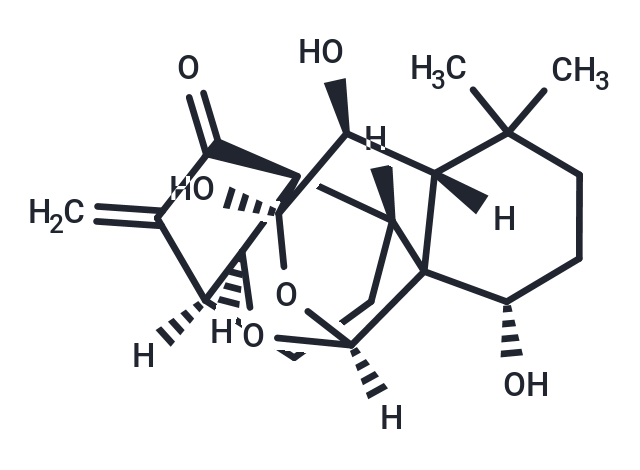Shopping Cart
- Remove All
 Your shopping cart is currently empty
Your shopping cart is currently empty

Ponicidin (Rubescensine B) is a diterpenoid derived from Rabdosia rubescens that exhibits immunoregulatory, anti-inflammatory, anti-viral, and anti-cancer activity. Ponicidin induces apoptosis of gastric carcinoma cells, decreases the phosphorylation of JAK2 and STAT3, and shows no effect on the protein levels of JAK2 and STAT3.

| Pack Size | Price | Availability | Quantity |
|---|---|---|---|
| 1 mg | $64 | In Stock | |
| 5 mg | $147 | In Stock | |
| 10 mg | $219 | In Stock | |
| 25 mg | Inquiry | In Stock | |
| 50 mg | Inquiry | In Stock | |
| 1 mL x 10 mM (in DMSO) | $117 | In Stock |
| Description | Ponicidin (Rubescensine B) is a diterpenoid derived from Rabdosia rubescens that exhibits immunoregulatory, anti-inflammatory, anti-viral, and anti-cancer activity. Ponicidin induces apoptosis of gastric carcinoma cells, decreases the phosphorylation of JAK2 and STAT3, and shows no effect on the protein levels of JAK2 and STAT3. |
| In vitro | K562 cells in culture medium in vitro were given different concentrations of Ponicidin (10-50 micromol x L(-1)) for 24, 48, and 72 h. The inhibitory rate of the cells was measured by MTT assay, cell apoptotic rates were detected by flow cytometry (FCM) using Annexin V staining after K562 cells were treated with different concentrations of Ponicidin for 72 hours, and cell morphology was observed by Wright-Giemsa staining. Ponicidin (over 30 micromol x L(-1)) could inhibit the growth of K562 cells in both time- and dose-dependent manner. FCM analysis revealed that apoptotic cells were gradually increased in a dose-dependent manner after treatment for 72 hours, and that marked morphological changes of cell apoptosis such as condensation of chromatin was clearly observed by Wright-Giemsa staining after treatment by 50 micromol x L(-1) Ponicidin. Furthermore, Western blotting also showed that expression of p-AKT and p-P85 in PI3K/AKT signaling pathways was downregulated dramatically whereas the expression of p-P38, as well as p-ERK and p-JNK, remained unchanged after the cells were treated by PON for 48 h. |
| Alias | Rubescensine B |
| Molecular Weight | 362.42 |
| Formula | C20H26O6 |
| Cas No. | 52617-37-5 |
| Smiles | [H][C@]12CC[C@]3([H])[C@]4(C(=O)C1=C)[C@@]2([H])O[C@@]1([H])O[C@]4(O)[C@@H](O)[C@]2([H])C(C)(C)CC[C@H](O)C312 |
| Relative Density. | 1.46g/cm3 |
| Storage | store at low temperature,keep away from direct sunlight | Powder: -20°C for 3 years | In solvent: -80°C for 1 year | Shipping with blue ice. | |||||||||||||||||||||||||||||||||||
| Solubility Information | DMSO: 250 mg/mL (689.81 mM), Sonication is recommended. | |||||||||||||||||||||||||||||||||||
Solution Preparation Table | ||||||||||||||||||||||||||||||||||||
DMSO
| ||||||||||||||||||||||||||||||||||||

Copyright © 2015-2025 TargetMol Chemicals Inc. All Rights Reserved.